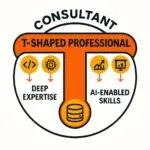Introduction
Change is never a one-size-fits-all journey. Over the years, I have guided organisations through transformations in banking, government, and industry. What I have learned is simple: successful change requires a balance between structure and people, between business goals and human experience.
ADKAR
One of the most practical models is Prosci’s ADKAR. It stands for Awareness, Desire, Knowledge, Ability and Reinforcement. ADKAR breaks change down into concrete steps that individuals must go through to adopt new behaviours. In my own projects, ADKAR often acts as a diagnostic tool: if a programme stalls, I can quickly see whether the issue lies in lack of awareness, insufficient skills or missing reinforcement.
Kotter
Another powerful approach is Kotter’s 8 Steps, which emphasises leadership and the power of momentum. From creating urgency to embedding change in the culture, the steps provide a roadmap for large-scale transformation. In one digital transformation project, I used Kotter’s principles to create short-term wins, visible improvements that convinced sceptical managers to support the wider programme.
Lewin
Kurt Lewin already described in the 1940s that change moves in three phases: unfreeze, change, refreeze. It sounds simple, but it captures the essence: people need to let go of old habits before they can embrace new ones. I often use Lewin as a metaphor when explaining to teams why rushing to implementation without preparation rarely works.
7S
The McKinsey 7S framework reminds us that change only sticks if both the “hard” and “soft” sides are addressed. Strategy, structure and systems need to be aligned, but so do style, staff, skills and shared values. In practice, I use the 7S to map out interdependencies. For example, introducing new systems without adapting leadership style or skills usually leads to frustration instead of progress.
Transition
William Bridges’ Transition Model makes a valuable distinction between change, which is external, and transition, which is internal. People go through three stages: ending and letting go, the neutral zone, and the new beginning. This model is particularly helpful in sensitive transformations where emotions play a big role, such as during reorganisations or mergers. I have seen leaders underestimate the letting go phase, which often creates hidden resistance later.
In Summary
What sets these models apart is their unique focus. Prosci is practical and diagnostic at the individual level. Kotter provides energy and leadership at the organisational level. Lewin offers a simple yet powerful foundation for pacing change. McKinsey highlights systemic alignment across the organisation. Bridges reminds us that people need emotional guidance, not just new processes.
From my perspective, the true value lies in combining them. No single model covers every angle. In digital transformations, I often mix ADKAR for adoption, Kotter for urgency and 7S for organisational alignment, while always keeping Bridges in mind to support people emotionally. Change is both a science and an art. These models give structure, but success comes from knowing when to use which lens. As a change professional, I see my role as bridging the business, organisational and human dimensions, because only then does transformation become sustainable.





